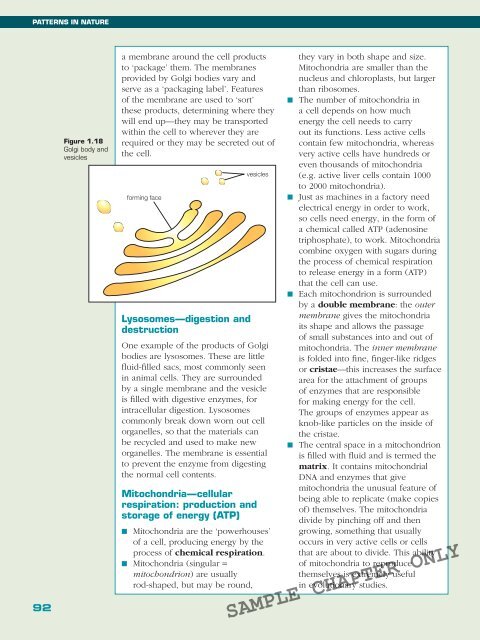BIOLOGY IN FOCUS
BIOLOGY IN FOCUS
BIOLOGY IN FOCUS
You also want an ePaper? Increase the reach of your titles
YUMPU automatically turns print PDFs into web optimized ePapers that Google loves.
PATTERNS <strong>IN</strong> NATURE<br />
92<br />
Figure 1.18<br />
Golgi body and<br />
vesicles<br />
a membrane around the cell products<br />
to ‘package’ them. The membranes<br />
provided by Golgi bodies vary and<br />
serve as a ‘packaging label’. Features<br />
of the membrane are used to ‘sort’<br />
these products, determining where they<br />
will end up—they may be transported<br />
within the cell to wherever they are<br />
required or they may be secreted out of<br />
the cell.<br />
forming face<br />
Lysosomes—digestion and<br />
destruction<br />
vesicles<br />
One example of the products of Golgi<br />
bodies are lysosomes. These are little<br />
fluid-filled sacs, most commonly seen<br />
in animal cells. They are surrounded<br />
by a single membrane and the vesicle<br />
is filled with digestive enzymes, for<br />
intracellular digestion. Lysosomes<br />
commonly break down worn out cell<br />
organelles, so that the materials can<br />
be recycled and used to make new<br />
organelles. The membrane is essential<br />
to prevent the enzyme from digesting<br />
the normal cell contents.<br />
Mitochondria—cellular<br />
respiration: production and<br />
storage of energy (ATP)<br />
■ Mitochondria are the ‘powerhouses’<br />
of a cell, producing energy by the<br />
process of chemical respiration.<br />
■ Mitochondria (singular =<br />
mitochondrion) are usually<br />
rod-shaped, but may be round,<br />
they vary in both shape and size.<br />
Mitochondria are smaller than the<br />
nucleus and chloroplasts, but larger<br />
than ribosomes.<br />
■ The number of mitochondria in<br />
a cell depends on how much<br />
energy the cell needs to carry<br />
out its functions. Less active cells<br />
contain few mitochondria, whereas<br />
very active cells have hundreds or<br />
even thousands of mitochondria<br />
(e.g. active liver cells contain 1000<br />
to 2000 mitochondria).<br />
■ Just as machines in a factory need<br />
electrical energy in order to work,<br />
so cells need energy, in the form of<br />
a chemical called ATP (adenosine<br />
triphosphate), to work. Mitochondria<br />
combine oxygen with sugars during<br />
the process of chemical respiration<br />
to release energy in a form (ATP)<br />
that the cell can use.<br />
■ Each mitochondrion is surrounded<br />
by a double membrane: the outer<br />
membrane gives the mitochondria<br />
its shape and allows the passage<br />
of small substances into and out of<br />
mitochondria. The inner membrane<br />
is folded into fine, finger-like ridges<br />
or cristae—this increases the surface<br />
area for the attachment of groups<br />
of enzymes that are responsible<br />
for making energy for the cell.<br />
The groups of enzymes appear as<br />
knob-like particles on the inside of<br />
the cristae.<br />
■ The central space in a mitochondrion<br />
is filled with fluid and is termed the<br />
matrix. It contains mitochondrial<br />
DNA and enzymes that give<br />
mitochondria the unusual feature of<br />
being able to replicate (make copies<br />
of) themselves. The mitochondria<br />
divide by pinching off and then<br />
growing, something that usually<br />
occurs in very active cells or cells<br />
that are about to divide. This ability<br />
of mitochondria to reproduce<br />
themselves is extremely useful<br />
in evolutionary studies.<br />
SAMPLE CHAPTER ONLY
















